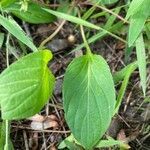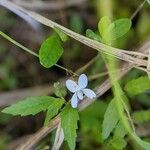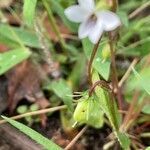Plants perennial, acaulescent, stoloniferous, 5–30 cm; stolons pale, often rooting and leafy at nodes; rhizome slender, fleshy. Leaves basal, 2–6(–9), ascending to erect; stipules linear-lanceolate, margins entire or irregularly lacerate (at least distally), apex acute; petiole 2–12 cm, glabrous or pubescent; blade unlobed, lanceolate or narrowly elliptic to nearly linear, 2.5–12 × 0.7–2.5 cm, longer than wide, base attenuate, margins serrate, mostly eciliate, apex acute, mucronulate, surfaces glabrous. Peduncles 2–17 cm, usually pubescent. Flowers: sepals ovate to lanceolate, margins mostly eciliate, auricles 1–2 mm; petals white on both surfaces, lowest and sometimes lateral 2 purple-veined, lateral 2 sparsely bearded or beardless, lowest 7–12 mm, spur white, gibbous, 1–2 mm; style head beardless; cleistogamous flowers on prostrate to ascending peduncles. Capsules ellipsoid, 5–8 mm, glabrous. Seeds beige to bronze, 1.5–2.5 mm. 2n = 24.







